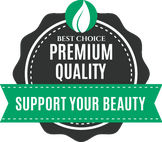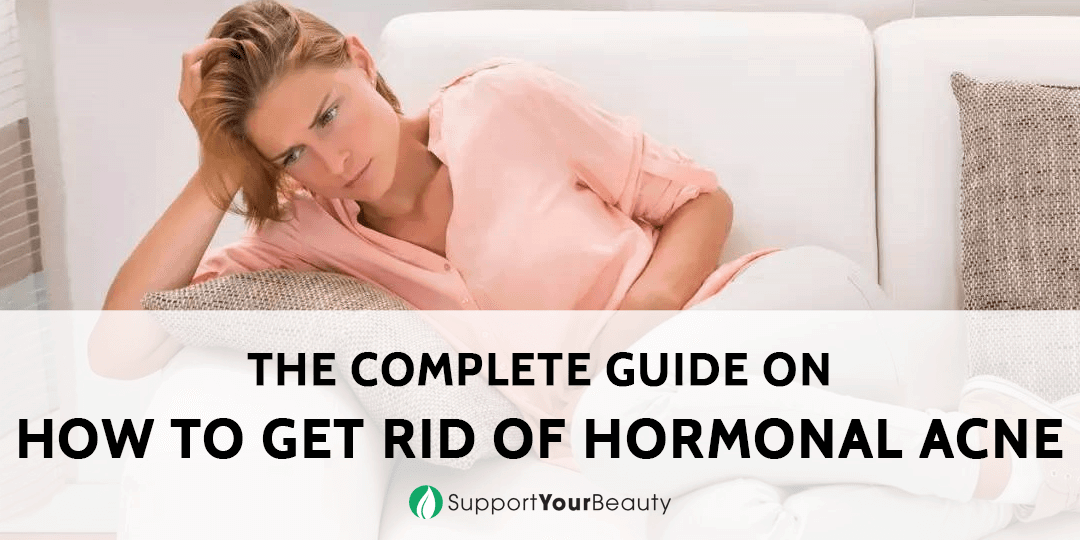
Feeling as if your problem is being censored, put on the blacklist? We are here to cover your needs on how to get rid of hormonal acne!
Having acne on any part of your body can be really frustrating.
Even though plenty of people consider hormonal acne as a minor skin issue, its repercussions are no joke.
What I hate most about getting pimples on my face, back, arms, or on pretty much any part of my body is that they not only make me feel uncomfortable, but they kill my confidence as well.
Fortunately, hormonal acne is highly treatable.
With the right guidance and the right set of medication, you will be able to completely get rid of hormonal acne in no time, and possibly for good.
More...
What Is Hormonal Acne?
If you are reading this article right now, there is a large chance that you or someone you know is looking into the best way to get rid of hormonal acne.
Hormonal acne is basically another term for acne or acne vulgaris.
However, hormonal acne is a term that isn’t often used by medical professionals, it has become a household word because of its frequent occurrence among teenagers who are going through hormonal changes caused by puberty.
As a basic definition, hormonal acne is a skin condition that affects mainly the upper part of the body and the face.
How to Control It With These 5 Proven Methods
Hormonal acne is a skin condition that can be prevented through several ways.
Here are a couple of methods that we highly recommend you to try if you truly want to get rid of hormonal acne outbreaks in the future.
Method 1: Ditch Processed Foods
Junk foods such as chips, cookies, or fries may taste really great, but they can significantly affect how your skin looks.
According to Dr. Albert Lefkovits, Park Avenue Center for Advanced Medical and Cosmetic Dermatology Director in New York City, "Eating chocolate or a lot of junk food doesn't by itself seem to cause acne, but not having a balanced diet and eating too many refined carbs can cause problems.”
If you can’t last long without eating a snack, you should at least try and opt for healthier choices such as fruits or other whole foods.
Just try to avoid foods that are filled with sugar, flour, and saturated fats.
Method 2: Maintain Cleanliness
Contrary to popular belief that bad hygiene leads to hormonal acne outbreaks, what you actually have to keep clean are the things that you often touch your skin.
In order to avoid spreading bacteria-filled contaminants on your skin, you should practice keeping your hands clean, using clean towels, bed sheets, handkerchiefs, or any other object that frequently comes into contact with your skin.
Method 3: Drink Green Tea
If preventing hormonal acne is your cup of tea, then you should go ahead and literally have a cup of tea.
Aside from having a refreshing taste, green tea is a type of food that can significantly enhance your overall skin condition.
What makes green tea an effective acne suppressor is its properties that fight increased hormone levels that cause hormonal outbreaks.
For best results, try and drink at least 3 cups a day.
Method 4: Try Probiotics
Another effective way to prevent hormonal acne outbreaks is consuming healthy probiotics.
If you aren’t familiar with probiotics, those are foods or beverages that contain good bacteria such as Lactobacilli.
What probiotics do is they help reduce acne causing sebum in your skin.
However, you must take note that most probiotics have a laxative effect, so don’t take in too much or you might end up going to the restroom frequently.
Method 5: See A Dermatologist
If you feel like your hormonal acne outbreaks are constantly coming back, one thing you could do is seek out a medical professional.
Though a couple of pimples on your body may seem like a minor skin issue to most people, there is no shame in seeking out medical help.
A professional dermatologist can provide you with individual specific information along with an effective skin care regimen and medication that can help clear your skin and prevent future outbreaks.
What Causes Hormonal Acne To Form?
Now that you know how to prevent hormonal acne from coming back, the next best thing you can do to totally get rid of hormonal acne skin issues is to learn about its causes.
Once you have a firm grasp of what causes hormonal acne to form, you will gain a better understanding as to how your body works.
In doing so, you will be able to take care of your body so much better than before.
There are several factors that can cause hormonal acne to form. The most common one is exposure to bacteria. The second most known cause is increased hormone levels.
When it comes to hormonal acne outbreaks, the main culprit is your testosterone hormones.
According to Briarcliff Manor Dermatologist, Dr. Whitney Bowe, “These hormones can trigger excess oil production and cause skin cells to become sticky, leading to clogged pores and breakouts.”
Increased levels of testosterone can cause your body to excrete more sebum. Sebum is the oily substance that covers the hairs in your body.
If you have noticed your hair getting greasy when you miss a shower, it’s the sebum that’s making it so.
Another factor that causes hormonal acne is a weak immune system.
Having a weak immune system can cause inflammation in many parts of the body, including existing pimples.
When existing pimples get inflamed, they don’t only become more painful, but can be spread easier as well.
The Best Rules
If you are really determined to get rid of hormonal acne on all parts of your body, try to practice these following tips:
Do Not Exfoliate
Though exfoliating scrubs can leave you with a really clean feeling in your skin, using such isn’t the best idea when you’ve got acne covered skin.
Acne causes your skin to become overly sensitive, exposing your acne to exfoliation scrubs may only lead to irritation or further harm.
Do Not Wash Too Much
The maximum times you should wash your skin is twice a day.
Anything more than that can cause your skin to become dry and easily irritable.
Do Not Touch Your Acne
We know it can be very tempting to touch, pop, scrub, pick, and scrape the acne on your skin.
But you must completely refrain from doing so because it will only irritate your skin or worse, leave unattractive lesions are near impossible to remove.
Do Not Use Cosmetics
If you are a constant makeup user, you must refrain from using cosmetics on any part of your body that is covered with acne.
Doing so will only contaminate your skin, clog your pores, and prolong your acne’s lifespan.
However, if you really have to use cosmetics, you may try using water-based ones that come with a Non-Comedogenic label.
Do Not Use Whitening Soaps
Whitening soaps often come with ingredients that can make your skin dry.
And when your skin is dry, acne covered areas not only tend to become more irritable, but lasts longer as well.
When to See a Doctor
Though a lot of people might disagree, we believe that you don’t have to have severe conditions in order to be viable to see a doctor.
Hormonal acne outbreaks are no joke, no matter the severity.
It is a skin condition that can significantly affect your self-esteem, skin health, and overall confidence.
If you are currently suffering from constant hormonal acne outbreaks, severe lesions, or major discomfort, it would be wise to seek out medical help for quick relief.
Be sure to see a certified dermatologist to ensure that your skin will be getting the best care.
How To Get Rid Of Hormonal Acne
One effective way you can try, no matter where it is on your body, is applying salicylic acid.
To do so, all you have to do is follow these simple steps:
Step 1: Check for Allergies
Before you use the salicylic acid on your skin, the first thing you should do is make sure that you aren’t allergic to it.
You can do so by applying a very small amount to two or three acne covered areas on your skin for at least three consecutive days.
If any allergic reaction appears, you should refrain from using it on your skin to avoid exacerbating your hormonal acne skin condition.
Step 2: Follow Directions Listed on The Packaging
If you decide to get some salicylic acid from a store, chances are you will get it in a packaging with a set of instructions.
Otherwise, it would be best to do some research first or to consult a doctor or pharmacist to avoid any unfavorable circumstances.
Step 3: Practice Safety Precautions
To avoid any unfavorable circumstance, you should be mindful of certain safety precautions when it comes to using salicylic acid.
Salicylic acid is a type of medication that is solely intended for skin use.
To avoid itchiness, swelling, or other forms of irritation, you must not let the salicylic acid get in contact with your groin, nose, mouth, cuts, scrapes, rashes, open wounds, and eyes.
If you accidentally get it on any of these areas, immediately flush the contaminated area with clean and cool water for approximately 15 minutes or until any symptoms of irritation subsides.
As another safety precaution, you should also be mindful of the appropriate dosage for your skin.
We know it can be tempting to use ample amounts on your skin in hopes of curing your acne faster, but that is not the case.
Instead of having a faster recovery time, you can actually end up making your skin condition worse.
For best results, try to use salicylic acid in small yet frequent amounts. Ideally, the topical salicylic acid should be applied twice a day.
Step 4: Wash Your Skin
Once everything is set, and you’ve made sure that the salicylic acid is completely safe for you to use, the next thing you should do is wash your skin.
When washing your skin, try to use mild soaps that don’t dry out your skin.
Thoroughly washing your skin will prevent contamination once you apply the salicylic acid onto your skin.
Step 5: Apply The Salicylic Acid onto Your Acne
After your skin has been completely cleansed, the next thing you should do is apply a thin layer to areas on your skin where acne is present.
Try to apply the salicylic acid to your acne at least once or twice a day, unless your doctor directs otherwise.
To apply the topical salicylic acid to your skin, place a small dab onto the area you want to cure.
Gently rub the salicylic acid onto the skin. You can do so using your fingers or clean cotton pads.
On the other hand, if you are using cleansers that contain salicylic acid, the best approach would be to wet the area you want to put it on first and then gently rub the cleanser onto your skin for approximately 20 seconds.
After applying the cleanser, simply rinse your skin with clean water and pat it dry with a clean towel.
Take note that cleansers with salicylic acid may require more applications throughout the day.
If the cleanser doesn’t cause dryness in your skin, try to use it at least thrice a day for best results.
The Bottom Line
There you have it - a step-by-step guide on how to treat hormonal acne.
Having acne on your skin can be an extremely daunting situation. It can cause discomfort, lower your self-esteem, and put a dent in your overall confidence.
Fortunately, you can easily get rid of hormonal acne with a couple dabs of salicylic acid and prevent future outbreaks by practicing several healthy lifestyle choices such as eating healthy.

